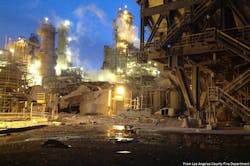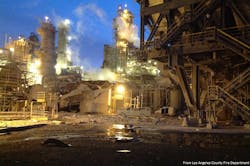CSB issues final report on 2015 FCC unit blast at ExxonMobil refinery
Multiple process safety management gaps led to a Feb. 18, 2015, explosion of the fluid catalytic cracker at ExxonMobil Corp.’s 149,500-b/d Torrance, Calif., refinery, the US Chemical Safety Board said in a final report it issued on May 3 (OGJ Online, Feb. 19, 2015). The incident seriously damaged the refinery and caused it to be run at limited capacity for more than a year, raising gasoline prices and costing California motorists an estimated $2.4 billion, it said.
Hydrocarbons normally do not flow into an FCC unit’s air side because it can create an explosive atmosphere, the report said. CSB’s investigation determined that on the day of the incident, a slide valve that acted as a barrier failed. This ultimately allowed hydrocarbons to flow into the air side, where they ignited in the electrostatic precipitator, causing an explosion.
“This explosion and near miss should not have happened, and likely would not have happened, had a more robust process safety management system been in place. The report concludes that the unit was operating without proper procedures,” CSB Chair Vanessa Sutherland said.
Process safety management gaps allowed the FCC unit to be operated without pre-established safe operating limits and a shutdown criteria, the report said. The refinery relied on safeguards that could not be verified, and reused a previous procedure deviation without a sufficient hazard analysis of the current process conditions, it said.
Finally, the slide valve—a safety-critical safeguard within the system—was degraded. The report noted that it is vital to ensure that safety critical equipment can successfully carry out its intended function. As a result, when the valve was needed during an emergency, it did not work as intended, and hydrocarbons were able to reach an ignition source.
In July 2016, ExxonMobil sold the Torrance refinery to PBF Holdings Co. LLC, which now operates as the Torrance Refining Co. Since the February 2015 explosion, the refinery has experienced multiple incidents, CSB said.
Its investigation also discovered that a large piece of debris from the explosion narrowly missed hitting a tank containing tens of thousands of pounds of modified hydrofluoric acid (MHF). Had the tank ruptured, it would have caused a release of MHF, which is highly toxic.
ExxonMobil, the owner-operator of the refinery at the time of the incident, did not respond to the CSB’s requests for information detailing safeguards to prevent or mitigate a release of MHF and therefore the agency was unable to fully explore this topic in its final report, CSB said.
Contact Nick Snow at [email protected].
About the Author

Nick Snow
NICK SNOW covered oil and gas in Washington for more than 30 years. He worked in several capacities for The Oil Daily and was founding editor of Petroleum Finance Week before joining OGJ as its Washington correspondent in September 2005 and becoming its full-time Washington editor in October 2007. He retired from OGJ in January 2020.

